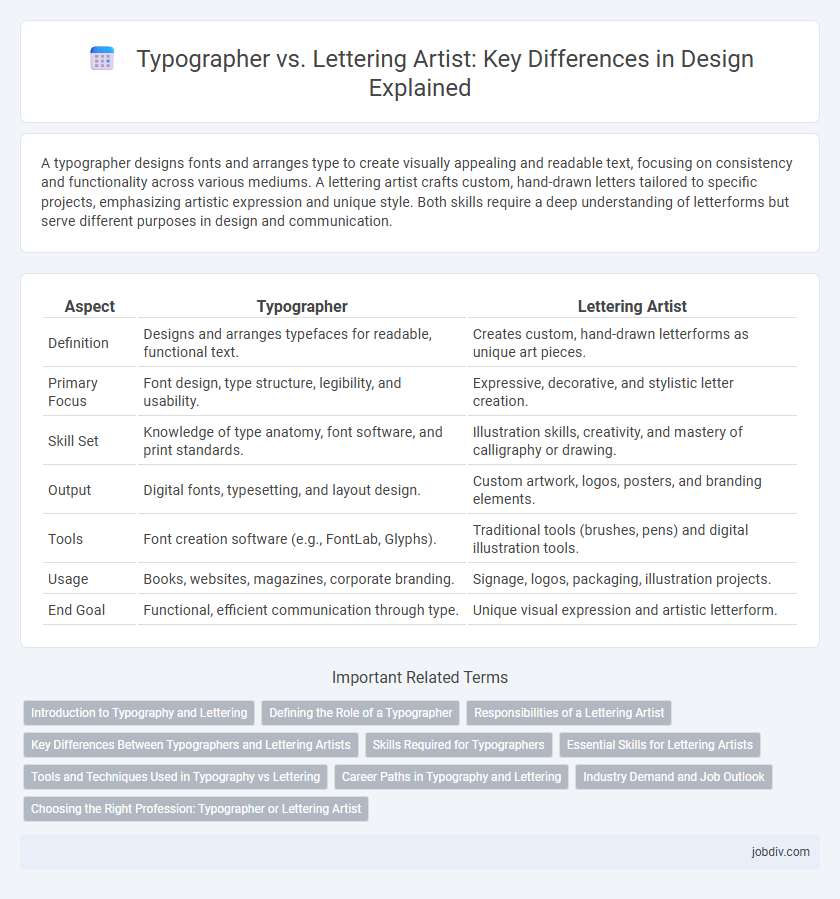A typographer designs fonts and arranges type to create visually appealing and readable text, focusing on consistency and functionality across various mediums. A lettering artist crafts custom, hand-drawn letters tailored to specific projects, emphasizing artistic expression and unique style. Both skills require a deep understanding of letterforms but serve different purposes in design and communication.
Table of Comparison
| Aspect | Typographer | Lettering Artist |
|---|---|---|
| Definition | Designs and arranges typefaces for readable, functional text. | Creates custom, hand-drawn letterforms as unique art pieces. |
| Primary Focus | Font design, type structure, legibility, and usability. | Expressive, decorative, and stylistic letter creation. |
| Skill Set | Knowledge of type anatomy, font software, and print standards. | Illustration skills, creativity, and mastery of calligraphy or drawing. |
| Output | Digital fonts, typesetting, and layout design. | Custom artwork, logos, posters, and branding elements. |
| Tools | Font creation software (e.g., FontLab, Glyphs). | Traditional tools (brushes, pens) and digital illustration tools. |
| Usage | Books, websites, magazines, corporate branding. | Signage, logos, packaging, illustration projects. |
| End Goal | Functional, efficient communication through type. | Unique visual expression and artistic letterform. |
Introduction to Typography and Lettering
Typography involves the art and technique of arranging type to make written language legible, readable, and visually appealing, primarily using pre-designed fonts and typefaces. A typographer focuses on selecting, spacing, and structuring these fonts for effective communication across various media. In contrast, a lettering artist creates custom hand-drawn letterforms, emphasizing unique and artistic expression tailored to specific design projects.
Defining the Role of a Typographer
A typographer specializes in the art and technique of arranging type to make written language legible, readable, and visually appealing, primarily focusing on font design, spacing, and layout in various mediums. This role involves careful consideration of typefaces, kerning, tracking, and hierarchy to enhance communication and user experience. Unlike lettering artists who create custom hand-drawn letters, typographers work extensively with digital tools to optimize type for print, web, and multimedia projects.
Responsibilities of a Lettering Artist
Lettering artists specialize in creating custom, hand-drawn letters tailored to specific projects, focusing on unique letterforms and artistic expression. They are responsible for developing bespoke letter structures that enhance the overall design, often collaborating closely with illustrators and graphic designers to integrate lettering seamlessly. Their expertise lies in balancing aesthetic appeal with readability, crafting visually compelling typography that serves branding or artistic goals.
Key Differences Between Typographers and Lettering Artists
Typographers specialize in arranging pre-designed typefaces to create clear, functional communication, focusing on readability and consistency across various media. Lettering artists create custom, hand-drawn letterforms or illustrations, emphasizing unique, expressive designs tailored to specific projects. Key differences include typographers' reliance on digital fonts and standardized characters versus lettering artists' emphasis on originality and handcrafted detail.
Skills Required for Typographers
Typographers require a deep understanding of type anatomy, spacing, and legibility to create visually coherent and readable text layouts. Mastery of software tools like Adobe InDesign and Glyphs is essential for designing and refining typefaces with precision. Strong knowledge of grid systems and typographic hierarchy enables typographers to effectively organize content and enhance user experience across print and digital media.
Essential Skills for Lettering Artists
Lettering artists excel in hand-drawing custom letterforms, requiring mastery in stroke consistency, spatial awareness, and creative interpretation of typography principles. Their essential skills include proficiency in calligraphy, illustration techniques, and an understanding of visual hierarchy to enhance readability and aesthetic appeal. Unlike typographers who work with pre-designed fonts, lettering artists create unique, expressive designs tailored specifically to each project.
Tools and Techniques Used in Typography vs Lettering
Typographers primarily utilize digital tools like Adobe Illustrator, FontLab, and Glyphs to create and manipulate existing typefaces with precision and scalability, emphasizing uniformity and readability. Lettering artists often rely on traditional media such as brush pens, markers, and calligraphy nibs to craft custom, hand-drawn letterforms that convey organic and expressive visual styles. The distinction lies in typography's focus on designing systematic fonts for repeated use, whereas lettering centers on creating unique, illustrative compositions tailored to specific projects.
Career Paths in Typography and Lettering
A typographer specializes in designing and arranging typefaces for readability and visual appeal across digital and print media, often working within branding and editorial design industries. Lettering artists create custom hand-drawn letters tailored to specific projects such as logos, murals, and packaging, emphasizing unique artistic expression and craftsmanship. Career paths in typography tend to involve roles in graphic design firms, publishing houses, and tech companies, while lettering artists often pursue freelance work, commissions, and collaborations with advertising agencies or boutique studios.
Industry Demand and Job Outlook
The demand for typographers remains strong in digital publishing and branding industries due to their expertise in creating functional, readable typefaces essential for user experience and accessibility. Lettering artists experience growing opportunities in advertising, packaging, and customized product design where unique, hand-crafted lettering enhances brand identity and visual appeal. Industry trends indicate steady job growth for both roles, but typographers benefit from broader applications in technology-driven projects, while lettering artists thrive in niche markets valuing artistic expression.
Choosing the Right Profession: Typographer or Lettering Artist
Choosing the right profession between typographer and lettering artist depends on skillsets and project goals; typographers specialize in designing and arranging typefaces for digital and print media, focusing on readability and consistency, while lettering artists create custom hand-drawn letterforms that add unique, artistic flair to branding and packaging. Understanding industry demands and personal strengths guides professionals toward careers in typeface design, font development, or bespoke logo creation. Mastery of software like Adobe Illustrator benefits lettering artists, whereas typographers thrive using tools such as Glyphs or FontLab for typeface creation and refinement.
Typographer vs Lettering Artist Infographic

 jobdiv.com
jobdiv.com